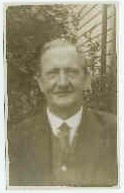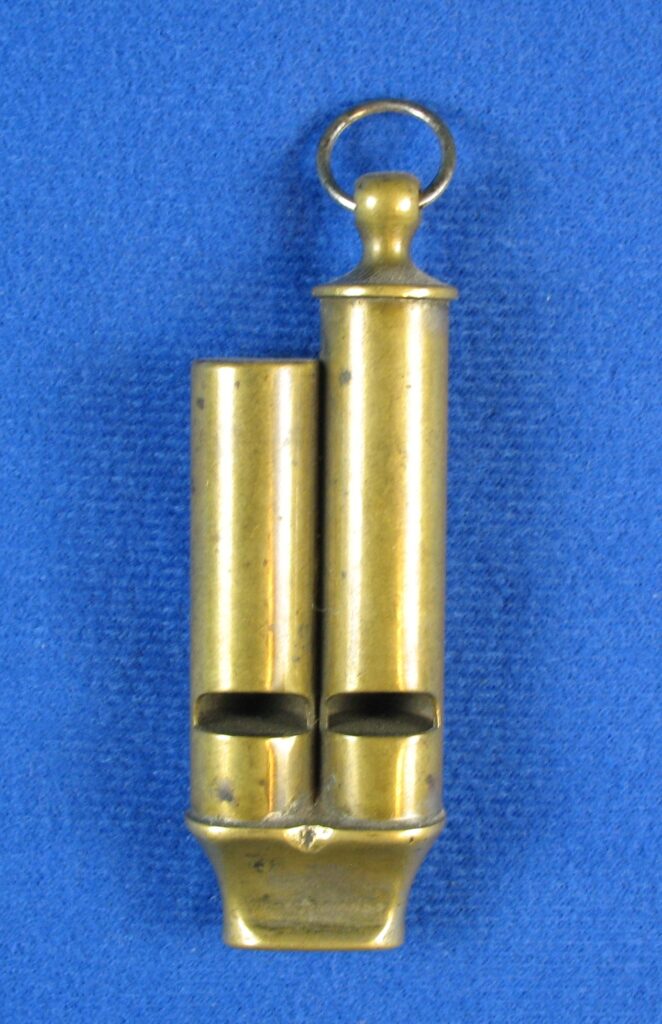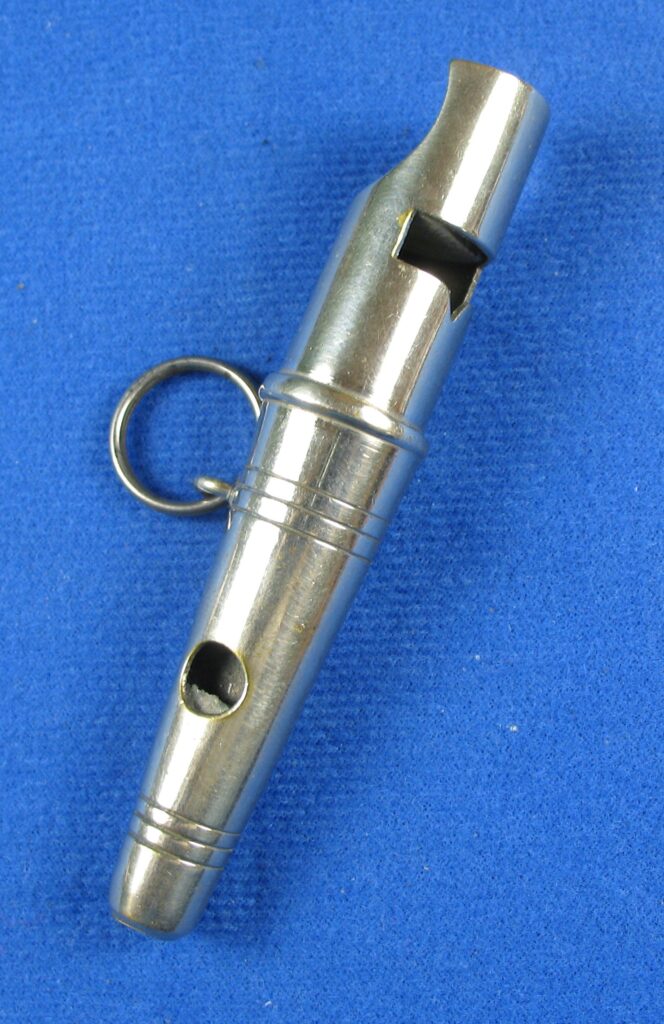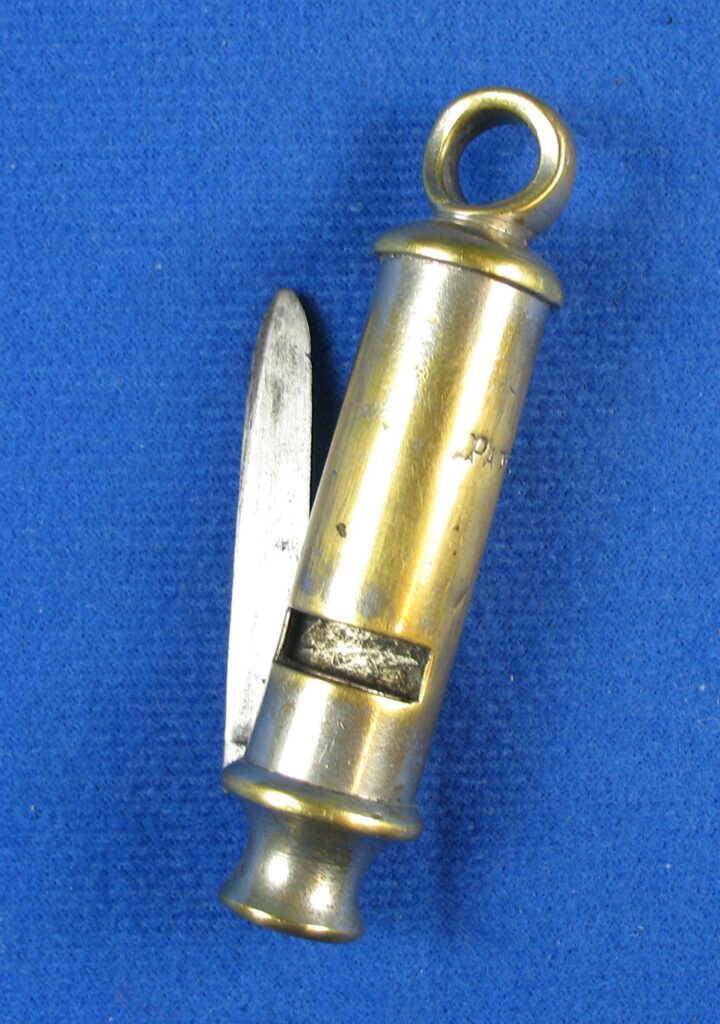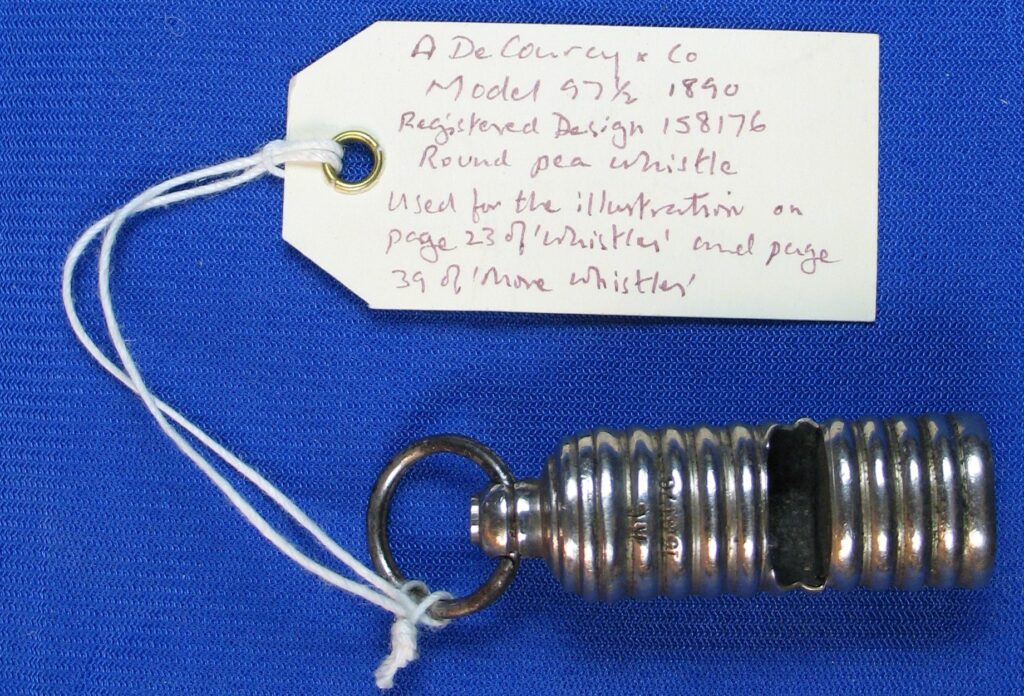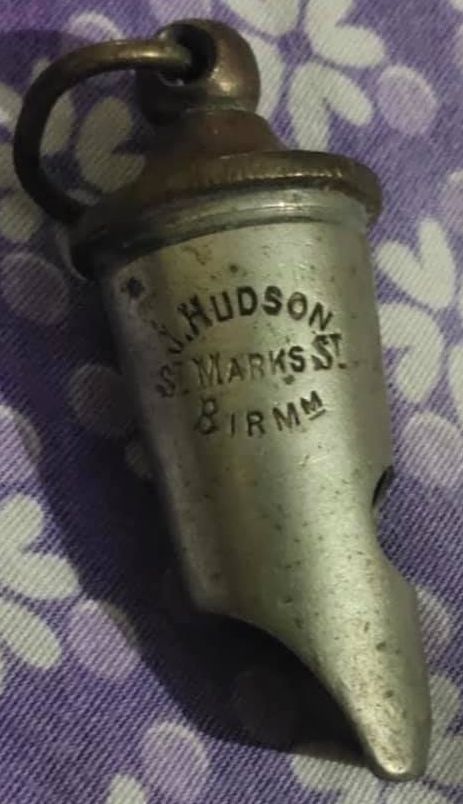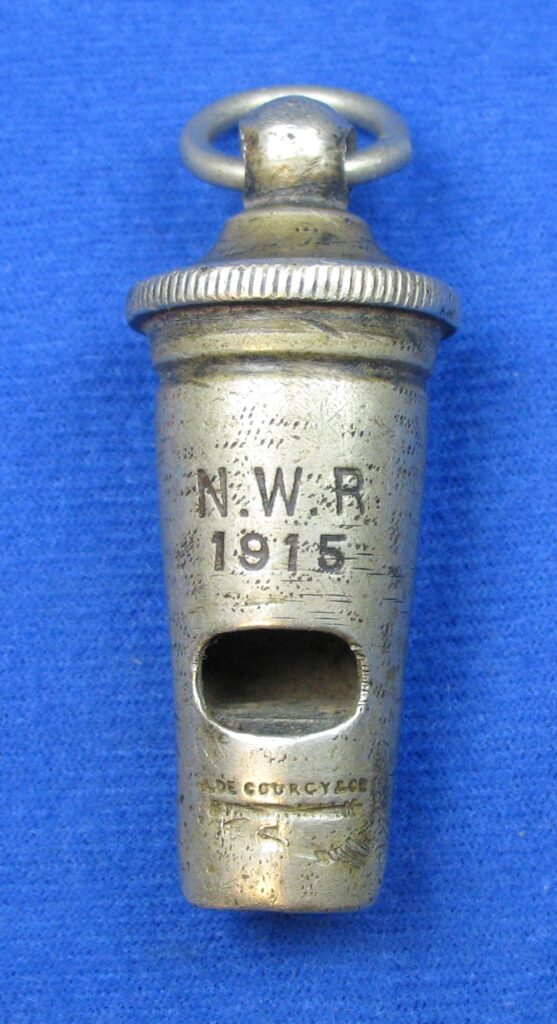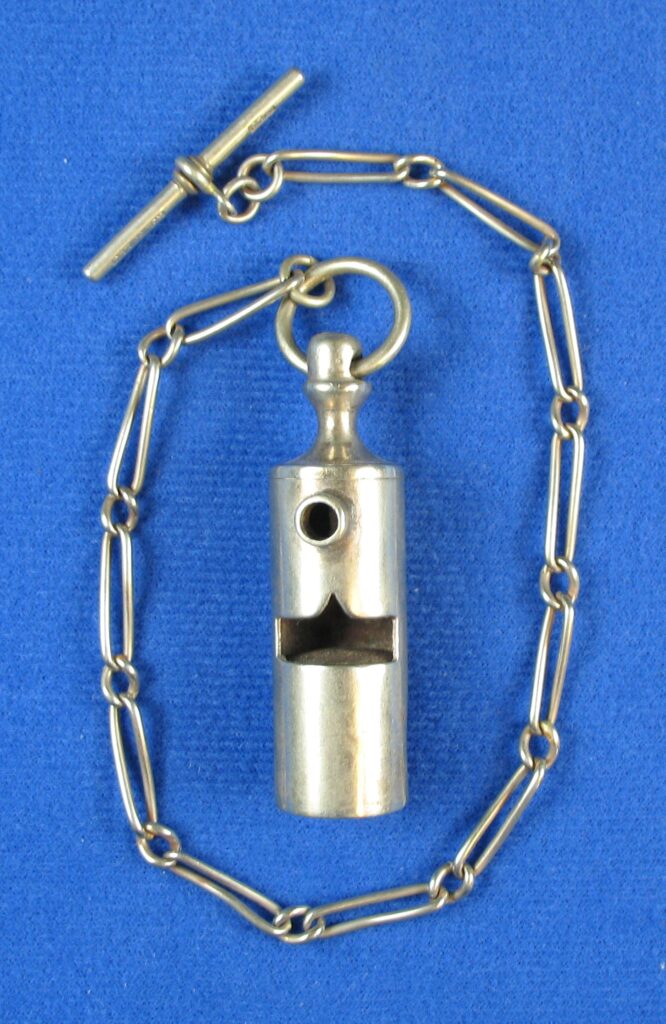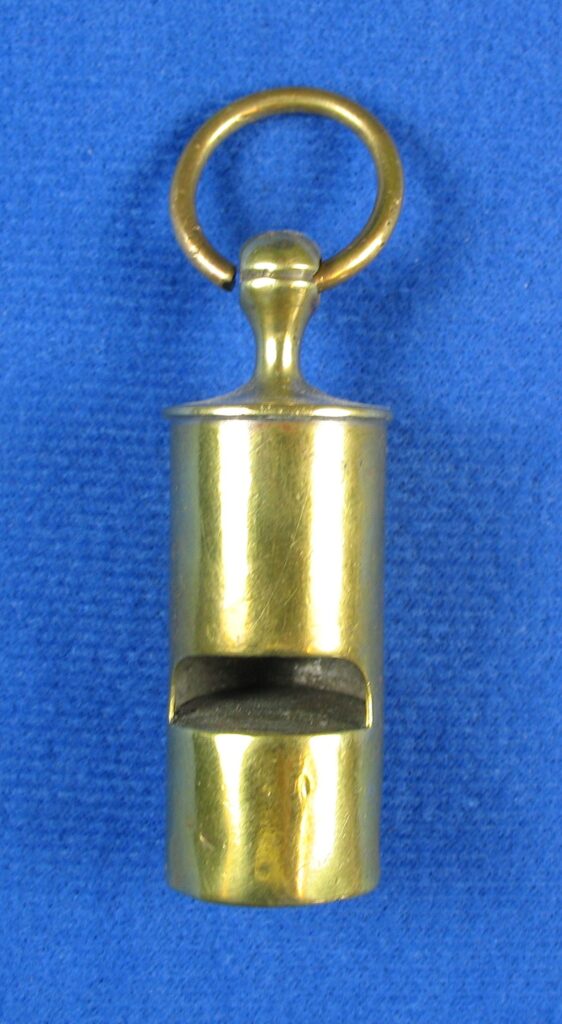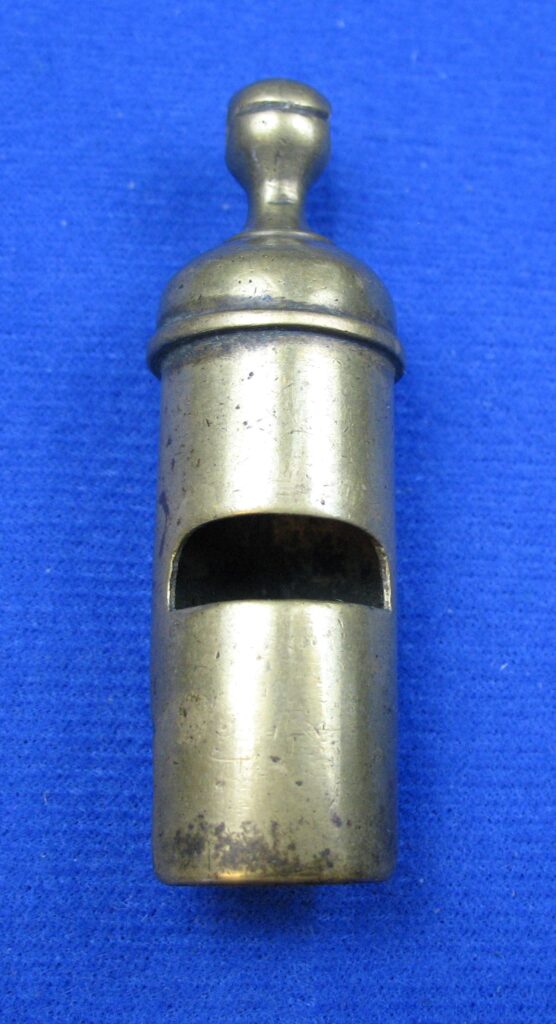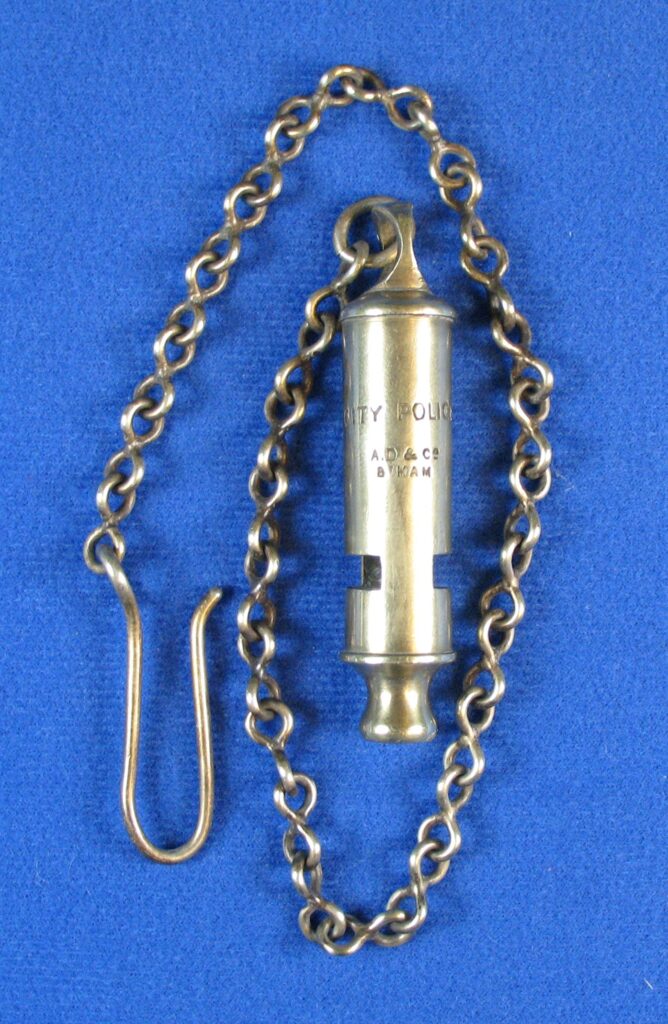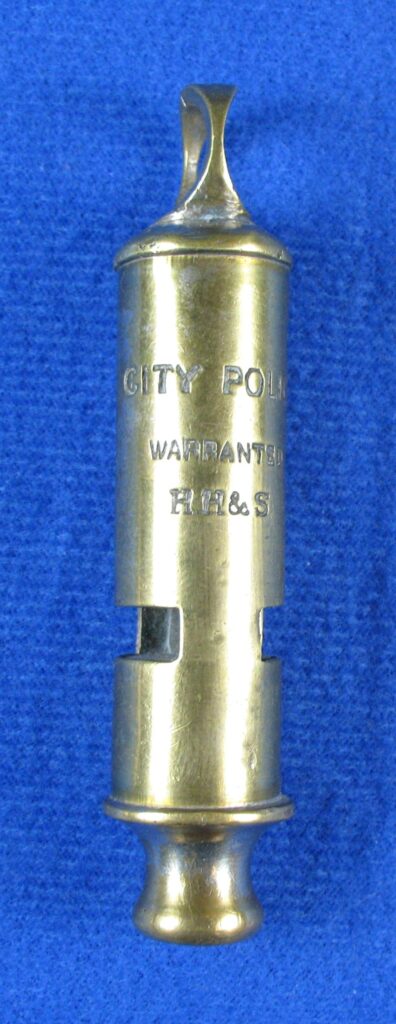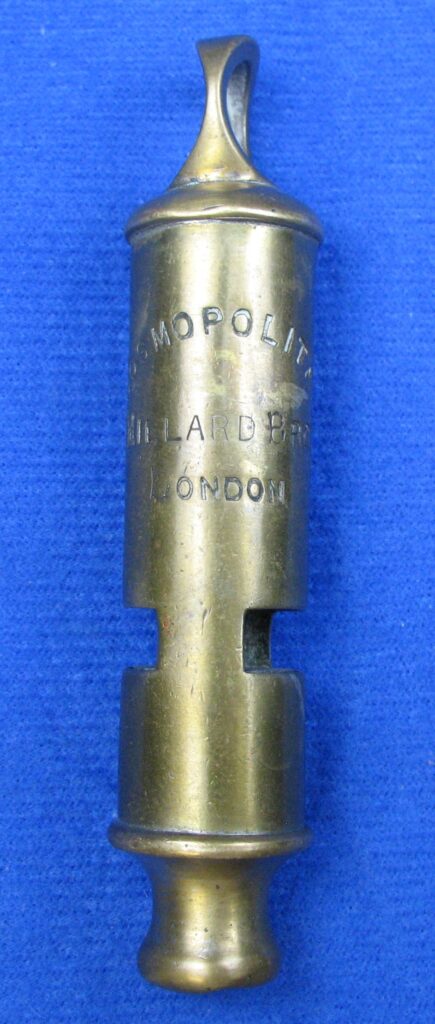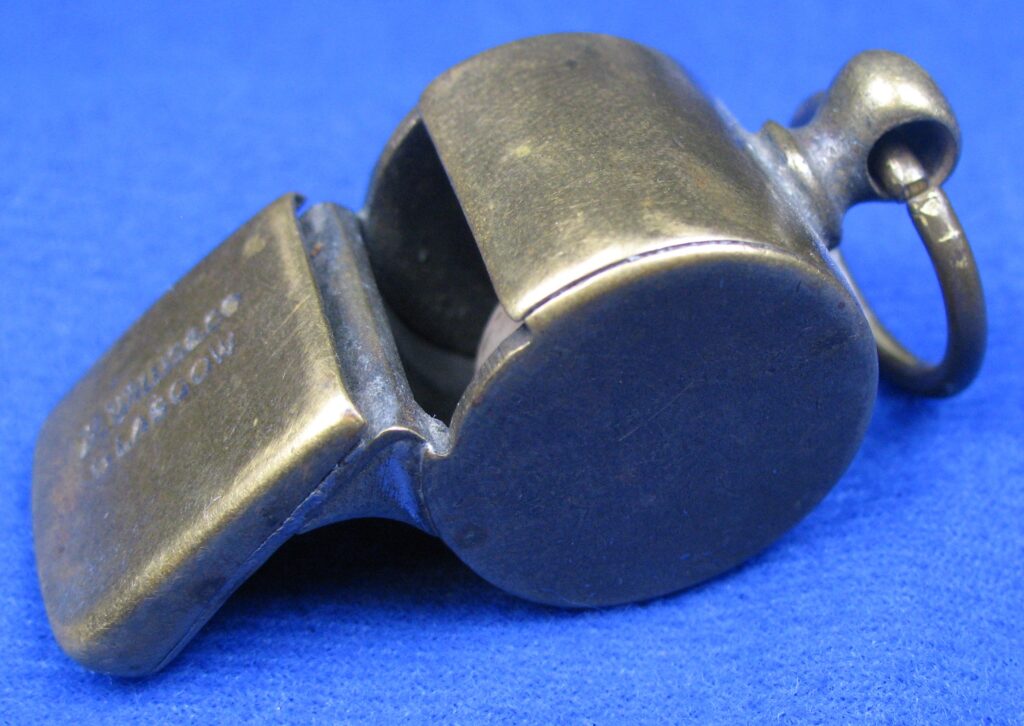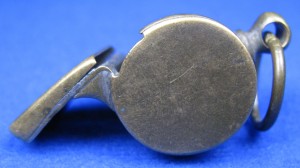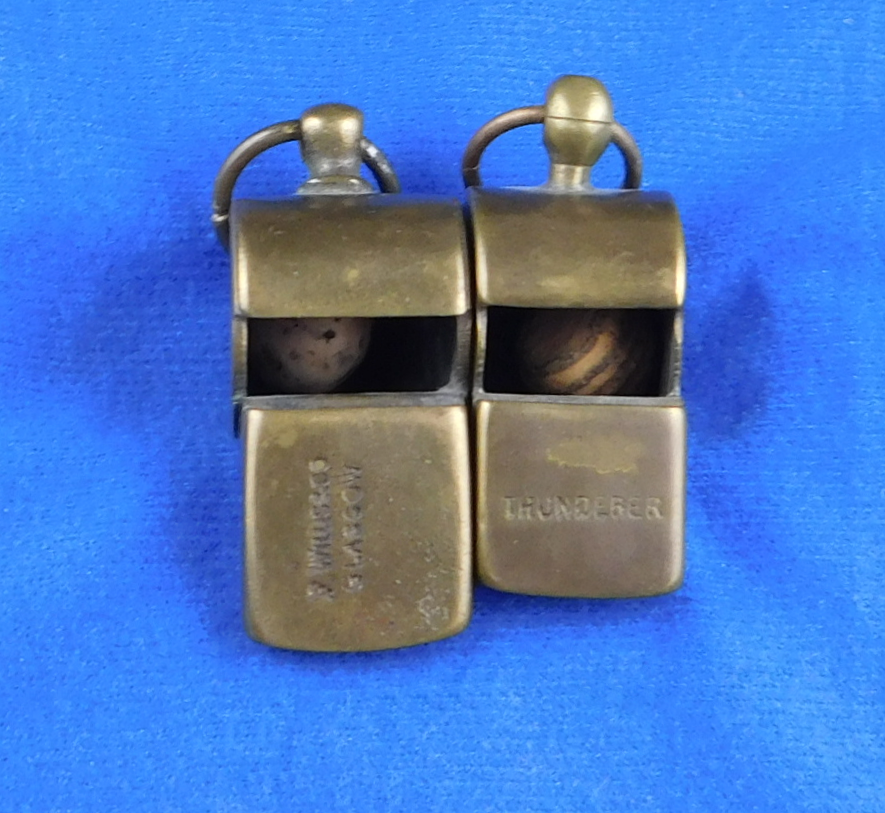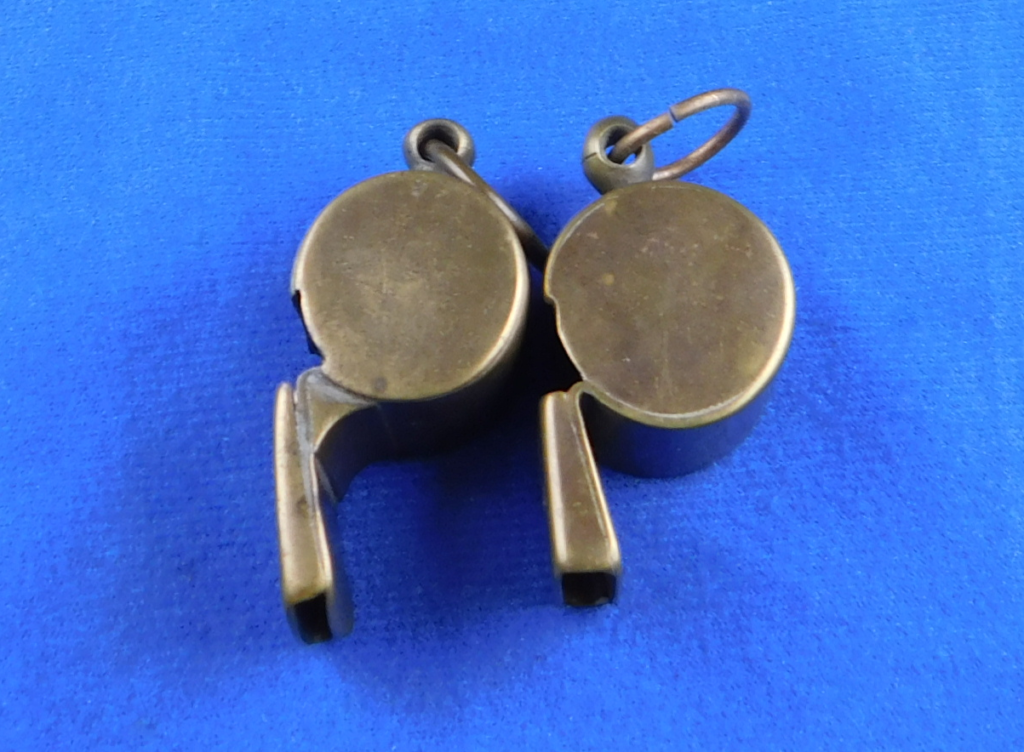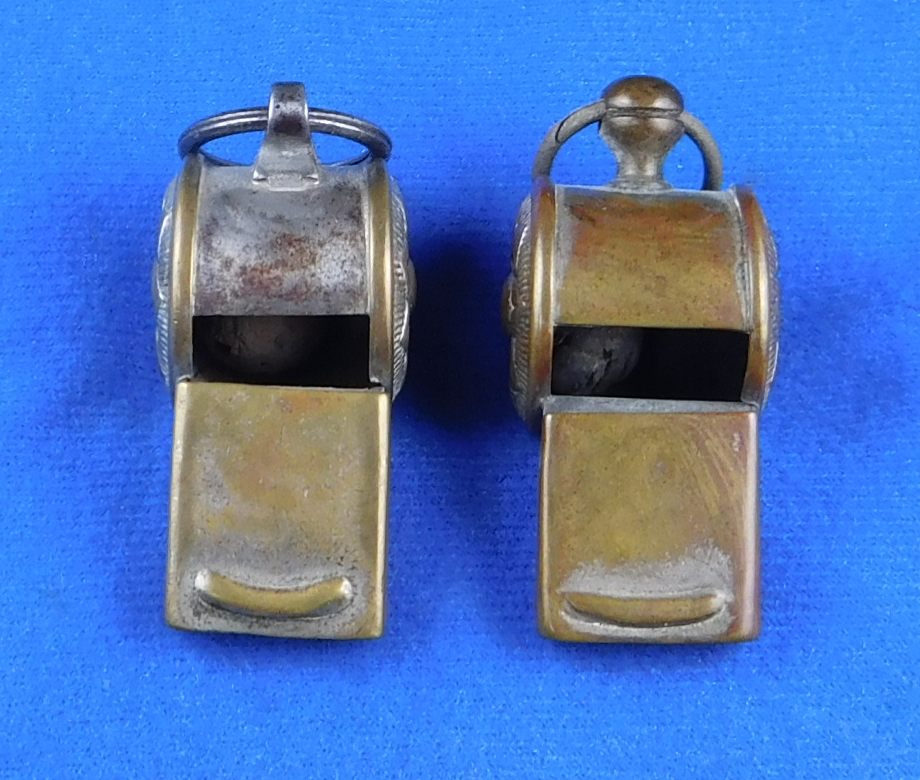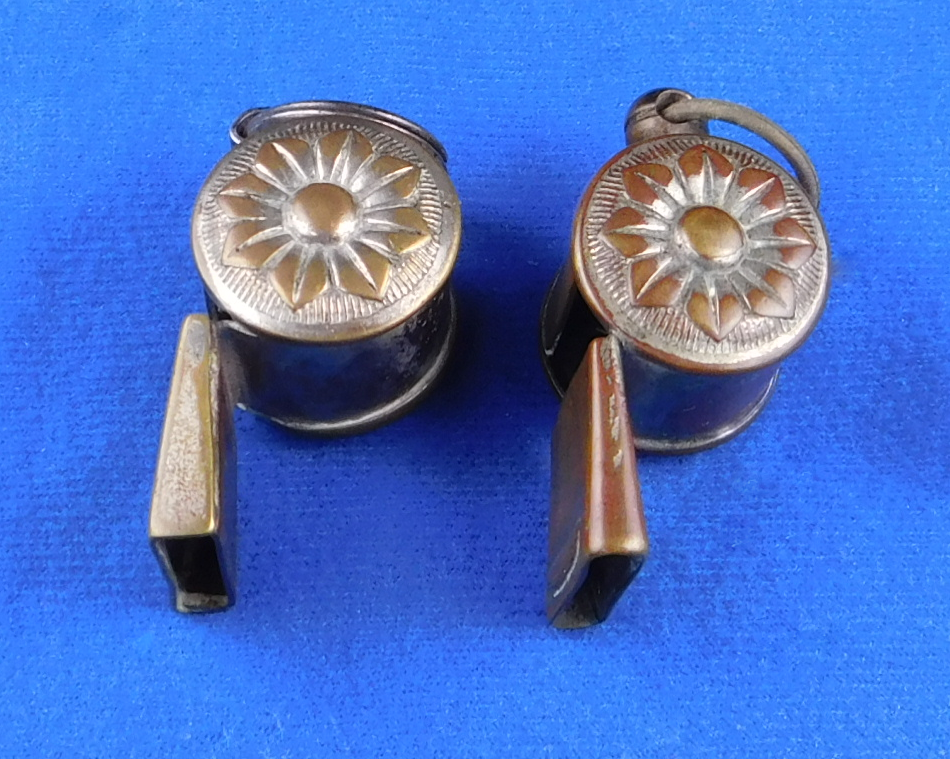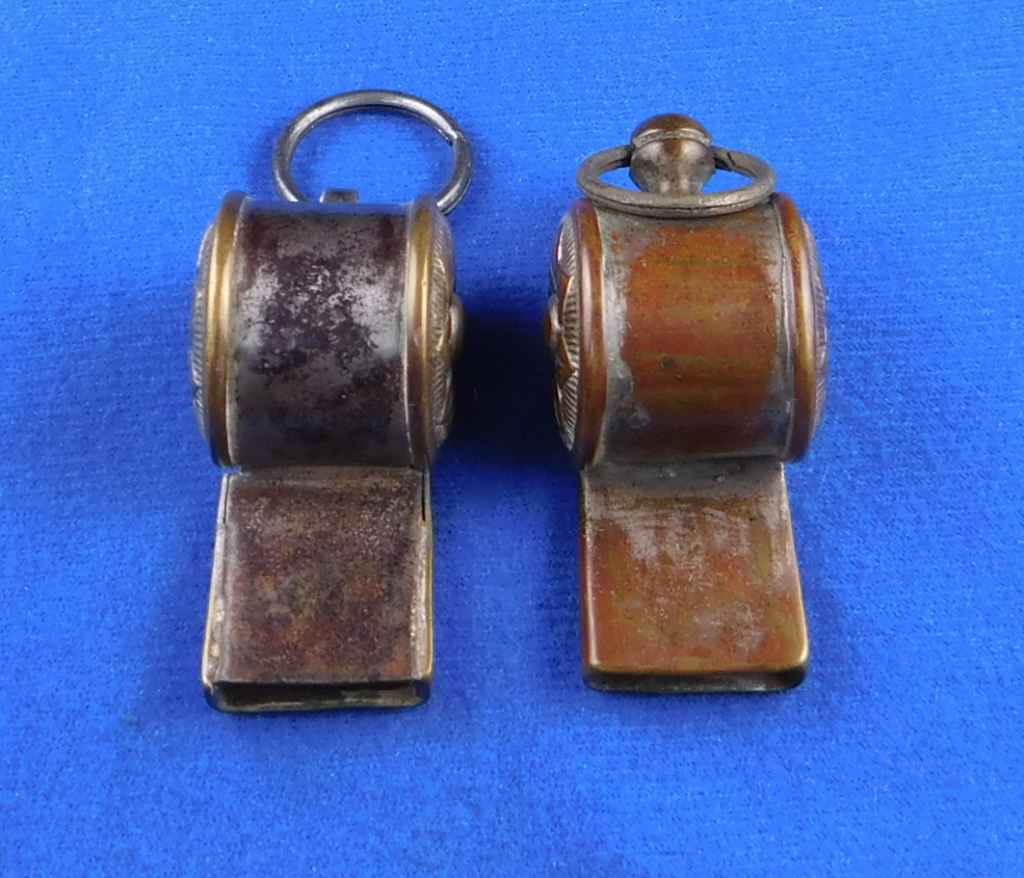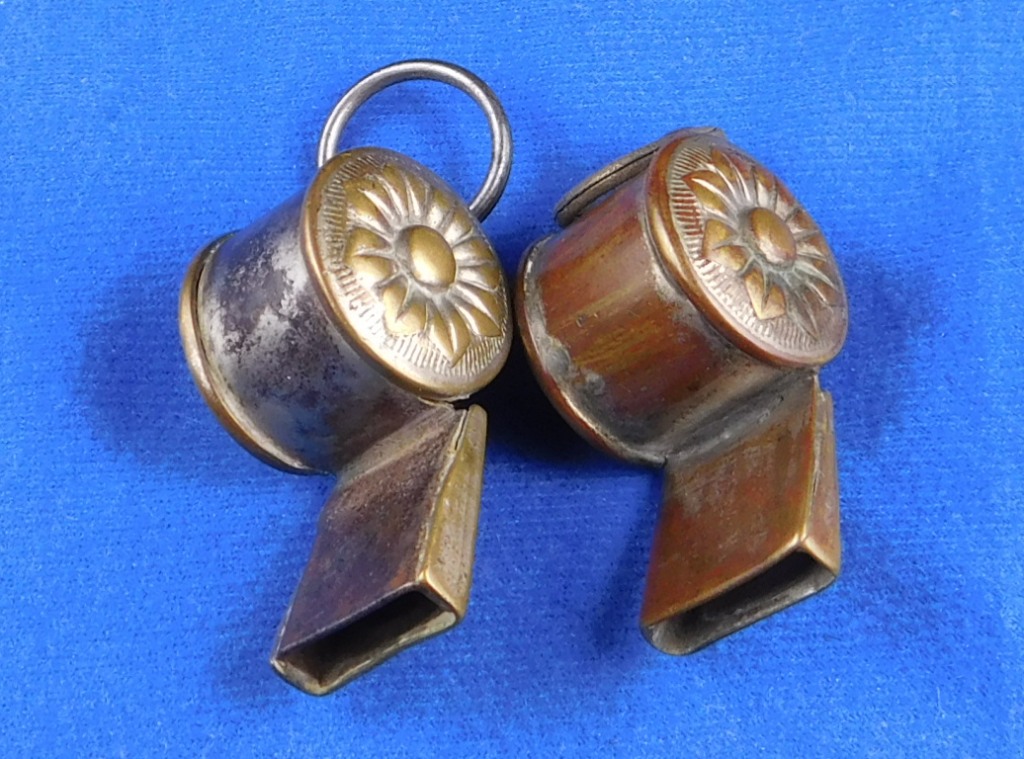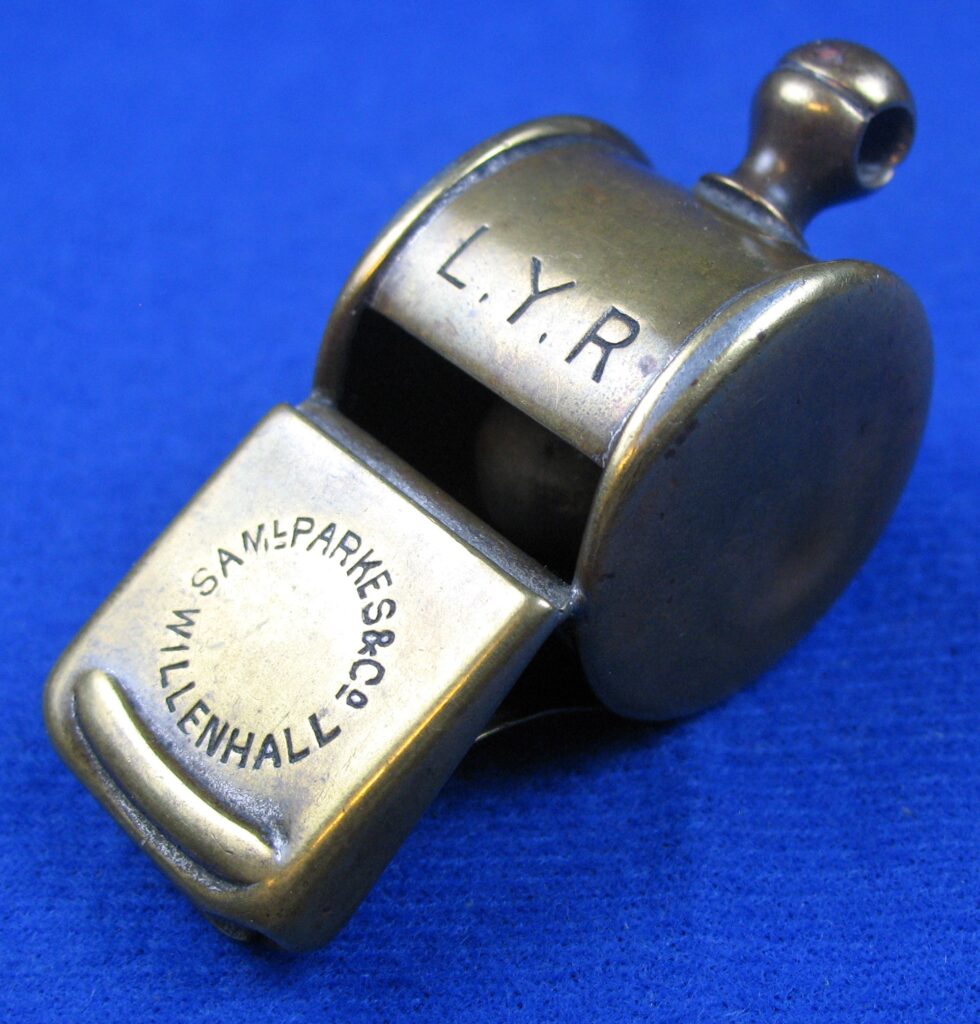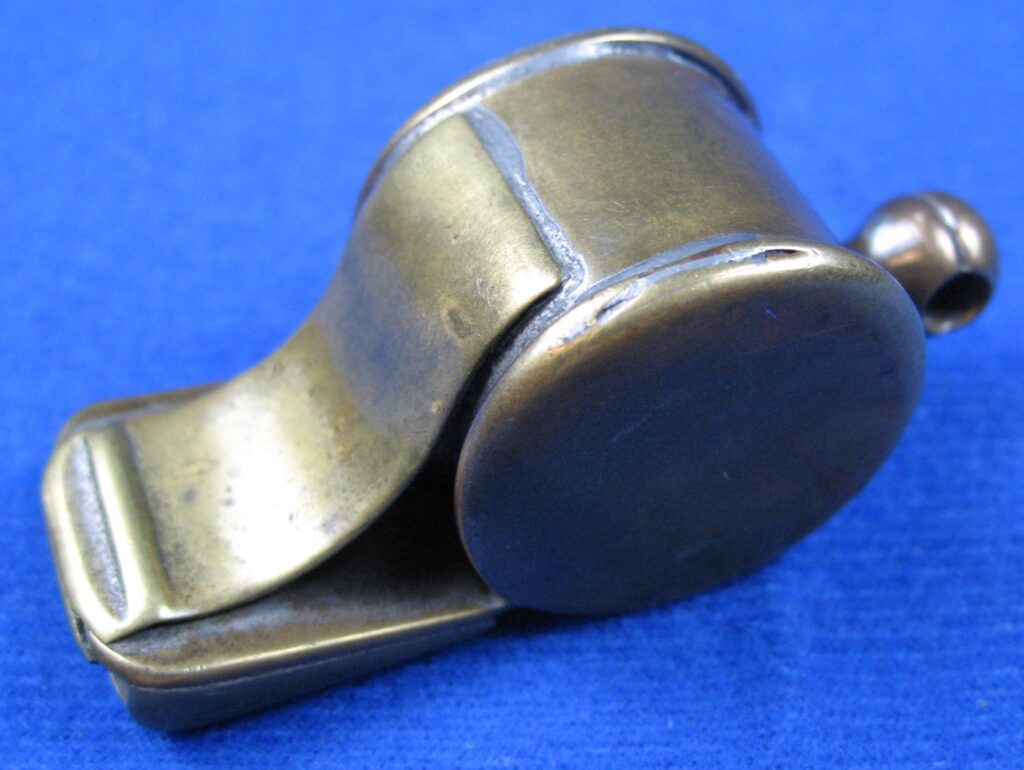Spotlight > Whistle Maker by Country > United Kingdom > DeCourcy > 007 Alfred DeCourcy – Part One, THE EARLY YEARS
Whistory
As obscure as whistle collecting is, information about the actual whistle makers is even more so. In this context we are referring to manufacturers that made production whistles as a business or at the least specialized in them, as part of their overall business. Alfred De Courcy is well known as a whistle maker and yet in general, we still know little about the extent of his early whistle making, before he officially started up the Police Whistle Works, circa 1904 ( one ad has Thunderer Whistle Works. – 1908 )
What is known about Alfred DeCourcy?
His patents were mainly from 1905 onward from Frankfort Street, — whereas he went on his own about 17 years earlier. After leaving Hudson’s as a foreman at the age of 21, he formed his own company and made whistles from 1888 to 1927. He had trained for 5 years there. Much like Joseph Hudson who trained at Bent and Parker, he left and started from scratch and little is known about these years before 1904. He was in close association with his brother Edgar during this time and through at least 1905.
One can read in more detail in Collecting Police Whistles by Martyn Gilchrist. In this SPOTLIGHT and a later one, we are endeavoring to look in some detail at the scope of a whistle designer and giving him further earned credit. To do so, we are to note two periods to Alfred’s whistle making…
1) 1888 to 1903 – ‘lost’ early years
2) 1904 to 1927 – later years
Why do we say so ? Although Alfred left Hudson’s to start his own business in 1888, he didn’t start stamping his name on his whistles till 1905-6. That left a period of 17 years of unidentified whistles.
Alfred De Courcy working as a foreman at Hudson’s alongside of Richard A. Walton.
Making things even more difficult is that there would be a natural overlap of construction techniques. After all he was a FOREMAN from Hudson’ s whistles. So expectedly there would-be difficulties differentiating some of his whistles from their whistles. Perhaps some infringements both ways. Now add to that another foreman who started earlier by just a year and left after Alfred left, Richard A. Walton. His tube whistles during these lost years were very similar.
A rundown of their comparative timelines would look like this working backwards:
- Edgar 44 (Richard was 49 ) in 1911
- Edgar 37 ( Ray 42 sold out same year to Hudson) expanded to Frankfurt St – 1904
- Edgar 31 on his own for ten years, probably at Dowler’s ( Ray 36 then left Hudson – 1898 )
- Edgar 21 ( Ray 26 or later, became foreman ) when DeCourcy left – 1888 – stayed 10 years
- Edgar 17 ( Ray is 23 when he started ) starts at Hudson 1883
Whistle Classification
| Category | escargots tube shape sirens beaufort (conical) round flat gadget combination boatswain (bosun) duplex heavy wall |
| Order | DeCourcy |
| Type | police fire military hunting navy scouts post office railway |
| Class |
Whistle Archeology
Edgar DeCourcy‘s role
An advertisement ( 1908 ) states he was established in 1888 and making whistles after leaving Hudson’s, apparently working with his brother Edgar. Edgar De Courcy is listed as a brass founder in 1901. Eventually he had two patents taken out in his name, 3725/1906 for tube shaped and 9499/1905 for a penknife.– this corrects information stating that Alfred patented these whistles. Surely Edgar’s brass skills helped in their manufacturing. His patents were circa 1905-6 and he had a daughter in 1911. They also lived close by each other. How much they worked together is unknown.
Also worthy of consideration is that Alfred registered a remarkable RIBBED designed round whistle in 1890, shortly after leaving Hudson’s, of which two models can be seen on page 39 of More Whistles. Notably his earliest tube shaped GSWs and POLICE whistles are with cast mouthpieces. This did not change until retooling at Frankfurt Street.
Police Whistle Works (later DeCourcy & Co.)
His move from 28 1/2 Mary street to Frankfort was for growth and a named business. The Police Whistle Works. ( later De Courcy & Co. ) 1904.His move from 28 1/2 Mary street to Frankfort was for growth and a named business. The Police Whistle Works. ( later De Courcy & Co. ) 1904.
This known, along with pictures of his whistles held in current collections indicates this to be true — that he was regularly making whistles during this early period. Please note the two pictured knife whistles on page 69 of CPWs ( Collecting Police Whistles by Martyn Gilchrist ) –dated to the 1905 patent . However, accurately dating any of his whistles earlier than 1905 becomes precarious, so we will date them c.1888-1904. Whistles by Alfred are still surfacing and adding to the overall picture.
Wikipedia over states “prior to this year (he) supplied many orders to railway, Police, Army, Navy, Asylums, Fire Brigades, sporting goods companies, arm distributors and hardware stores as well as for other makers as W Dowler & Sons and B Lily & Sons.”
We know of no written records or many examples to substantiate this generalization. Whistles from these lost years remain rather rare. No Asylum whistles are known, nor whistles for B Lilly.
Catalogs do exist but rare and are not posted yet. Some whistles are readily available like whistles made for Dowler, military, and police, post 1900, while others are rare or not even known to exist yet. Police/fire, fire brigade suppliers exist, but no fire brigades per se whistles. However quite a few have been gathered into collections with various stamps and are substantiating railway, sporting good, police.
Since all the records from Alfred’s whistle business were burned years ago ( 1969 – Gilchrist ), it is a matter of documenting from old trade catalogs, advertisements ( as yet unpublished ), finding pictures of his whistles in collections and museums and also city records, advertisements and the like. It is a reconstruction work.
Alfred DeCourcy Family Tree Notes (not always accurate)
Father – John Williams DeCourcy
Mother – Susanna Ridding
4 sisters, 2 brothers
1867 year of birth
1883 goes to work at 17 for Hudson’s ( coincidental with Hudson’s first large order )
1888 leaves Hudson starts his own business at 28 ½ Mary Street
1890 marries Mary Ann Condren
1891 living at No9 Court House 1, Villa Street, has 3 girls and 1 boy.
1901 Edgar working as brass founder, living 4 Carlyle Road, in Lozells, Aston Manor
1904 moves business to 20 Frankfort St
1924 moves to Orphanage Rd.
1927 sells to Hudson whistle part of company
1931 dies of peritonitis, Birmingham General Hospital
This SPOTLIGHT falls on Alfred’s early ‘lost’ years, and more succinctly, the variety and workmanship of a very talented whistle manufacturer during 1888 to 1904, which continued into his later years.
Interestingly Alfred did not utilize tines for his partitions.
| Patent # | Year | Title |
|---|---|---|
| 9499 | 1905 | Call combined with a penknife |
| 20619 | 1905 | 4 Piece + top fitting London style escargot-type |
| 3725 | 1906 | Diaphragm & Partition |
Whistology
Spherical
First up let’s look at More Whistles on page 73 top right. It shows a spherical whistle with spokes as being by A. De Courcy. ( this follows up a picture in Whistles page 19 where there is a question mark, now removed ) It is an early looking design, but not dated. We have not seen it surface, so we will for now follow Martyn’s lead and go with his judgment from years of examining whistles there in the UK. Logically it would be a cycling whistle and would place it circa 1900. You will need the book to see it as we cannot violate copyrights and show it to you. Ball shaped with a small tube protruding at the top edge. Plastic construction.
Dual Tube
Next up we peer at a dual tube ( in-line ) heavy wall whistle of plated brass. It has one knop on the longest tube. These typically were also made prior to 1900 by Ward, Barrall and 3 by Hudson.
We note the wider ‘arched’ openings to the windows ( left ) — typical of De Courcy ( as did Hudson and Ward ). Indeed, Alfred took his whistle skills with him from Hudson’s. Perhaps due to his training at Hudson’s his whistles and theirs are hard to differentiate in this respect.
Combination
That is also true of the combination whistle here that would seem to be Hudson. However due to the round whistle design, the diaphragm, etc. we are assigning it to Alfred. Perhaps all that training as a young man contributed to Alfred’s appetite for variety and of course what he saw at Hudson’s factory being possible to make.
Scout
Let’s look away again to the second whistle in More Whistles that was pictured with the cycling whistle and that is a flat scout whistle. Martyn dates his there to late 1890s ( unlikely ) to early 1900s. The scout movement was under way about the unofficial start date of 1907 under Baden Powell. 1909 in the states.
Sometimes referred to as vest or pocket whistles too, they come with scout stamps most often.
Pen knife combination
Another radical turn to a unique ‘outside the box’ idea — a De Courcy designed pen knife combination patented 1905 ( Edgar ). Combination ‘gadget’ whistles had been seen for decades prior. There were vestas, extractors, corkscrews, even knives and more. However, he did not make a knife with a whistle inside it. He reversed this and made a whistle with a knife inside it, and innovative, so much so that Hudson bought the rights later.
Rounds
Continuing on down, we come to a more difficult area than even the overlap of construction lines between Hudson and De Courcy.
Prior to the early years of Alfred’s whistle making was Henry Arthur Ward. One of the more obscure, but accomplished manufacturers of circa 1880 whistles also from Birmingham. A later court case reveals that Ward was ordering from De Courcy Thunderer escargots during these early years.
Formerly we had thought that the primary use of the window on rounds with wider arching windows was restricted to Hudson and De Courcy. It would appear that H.A.W. also utilized them, along with square and lower arching windows at least on his round whistles. This makes it more slightly difficult assigning whistles to the right maker.
After leaving Hudson Co in 1888, Alfred in 1890, just two year later registered this round design model 97 ½ and a smaller model ( 158176 ) He was just 23 years old.
The N.W.R. railway round ( originally designed by Hudson circa 1880 prior to moving to 84 Buckingham Street in Birmingham. ) also reflects this early work.
To see the smaller model see page 39 of More Whistles, the bottom right picture.
1890 DeCourcy appears in a trade directory. He is now 23 years old. Trade directories list him till 1903. Gilchrist reports that he was listed in a trade directory that same year as a whistle manufacturer and that it would take a year or two to get published in the trade directory, meaning that he was already making whistles right from the start.
M. Gilchrist also records that Alfred left apparently with some arrangement with Wm Dowler & Sons, probably fabricating whistles using their equipment, either leased or as a foreman. He then leaves to start his own company the same year that they cease making whistles.
His 1908 advertisement claims establishment 1888.
The N.W.R. railway round ( originally designed by Hudson circa 1880 prior to moving to 84 Buckingham Street in Birmingham. ) also does indeed reflect their early work, However DeCourcy’s whistles known of this model date 1905 to 1915.
Here one can see the wider arced windows and also a similar to Dixon ( left ) cut, although straight top edge rather than upsweeping.
As said in More Whistles beauforts continue to be hard to date because manufacturers used the same wedge diaphragm for decades. It is also hard to assign the maker at times, but there are some details to look for.
Of course, that would depend, as long as they weren’t ordered from someone else, and another’s stamp used. Here are a several early beauforts for examination.
Alfred DeCourcy, The “Assistance”
Please note the unusual ‘beaufort’ style of the ASSISTANCE (77mm), a trade name used by Alfred De Courcy. It has attributes from three types of whistles. It is shaped like a beaufort but has two windows shaped like his round whistles AND a diaphragm like a GSW. It has acast mouthpiece and top. In his later years he would use a rolled mouthpiece on this whistle model.
The larger beaufort (84mm) on the right also has a cast top and mouthpiece, but with a wedge diaphragm. The middle whistle is a generally standardized size (74mm) with again, wedge diaphragm.
Alfred DeCourcy and ‘Rolled’ Mouthpieces
There are whistles of a tubular construction made by Alfred from this early period.
Only one early year period whistle – London Police, has been found of police issues. All others known presently ( 10 ) come after 1905. However, his early GSWs with other stamps appear to be somewhat later after the Frankfort move. They no longer used cast mouthpieces, perhaps retooling for rolled mouthpieces in 1904-5.
Whatever the timing, at some point circa 1900 he started using ‘rolled’ mouthpieces before the 1906 patented diaphragms were used. The tops are cast of course, but the mouthpieces date them only generally. Creating a loose benchmark, so if cast, then pre 1904, if rolled post 1904.
Please let us know if you find corrections or other notes to post and we will post them here. Pictured are three examples of his early work and stamps… all with cast mouthpieces. Note that they are very similar to Walton who made whistles for 6 years on his own after he also left being a foreman at Hudson’s – 1898.
Lastly, we close our discussion by looking closely at escargots prior to the 1904 move. Alfred’s love for variety can be seen in his escargots too. London types were the earliest efforts by all makers ( following button whistles ) from the 1880s and into the 1890s. Was Alfred making these too? Yes.
As far as heavier manufactured escargots, if you refer to More Whistles page 14 look to the picture second from the bottom and on the right. There you will see an example of a sturdy 5 piece escargot with his name De Courcy stamped on the bottom. The 5 piece construction design had already been in use by others distributed by Black and company, — and he used it too.
This would have been only in his early period, as they ceased to be made shortly thereafter, giving way to the sturdier Hudson 3 piece design of 1891 of Hudson’s patent. De Courcy’ addition of a grooved tongue attachment to the barrel base seems to be the only variation.
Of note…
Next is another 5 piece whistle, this one from the reference collection, but is it a 5 piece? Look closely at the picture below and you will see this whistle is actually made of 6 pieces. So, there are two types of 6 piece whistles. One the heavy Glasgow design and this lighter almost London design. There is that extra sixth piece of under strengthening below the mouthpiece.
Note the similarity in a circa 1890 Thunderer, possibly by De Courcy. Perhaps at this time De Courcy was supplying Thunderers to Ward and possibly Black and Company.
Early escargot whistles prepped De Courcy for his 1905 patent with an innovative ‘fold over top’ to the mouthpiece.
This ‘flower’ type button side wall evolved over the years and was a transition from the heavier 5-6 piece escargots.
The whistle on the left is a lightweight London type with the top of the mouthpiece a separate piece attached However the right whistle is a fold over top piece.
Gilchrist would state on page 13 of More Whistles that “no examples of this call are known”. This appears to be a use of this patent design.
The whistle on the left preceded the fold over patent.
About this time Alfred was making this matching whistle with under strengthening, lighter, almost button type escargots ( LYR ) in effect a 6 piece also. The LYR railway used the fold over method.
There is nothing new here in escargot concept, as Hudson was already well into them and perhaps Alfred had made some of these too before leaving that establishment. However, the fold over is quite different as well as the modified under support that slipped over the front edge of the mouthpiece entry.
In 1905 a patent described a fold over mouthpiece on an escargot as follows.
Improvements in Railway and other Whistles and in their Manufacture
| Page bookmark | GB190526019 (A) – Improvements in Railway and other Whistles and in the Manufacture of same. |
| Inventor(s): | COURCY ALFRED DE + (ALFRED DE COURCY) |
| Applicant(s): | COURCY ALFRED DE + (ALFRED DE COURCY) |
| Classification: | – international: – cooperative: |
| Application number: | GBD190526019 19051214 |
| Priority number(s): | GBT190526019 19051214 |
Abstract of GB190526019 (A)

26,019. Courcy, A. de. Dec. 14. Making whistles. -A whistle is formed from four stamped pieces of metal. One piece A is first bent into the shape shown in Fig. 3, with a strengthening-strut a<3>, which may if necessary be absent, two side pieces B, Fig. 9, are then attached, and the pieces b<2> are folded over, forming with the piece C the top of the whistle.
Conclusions
It is not hard to see why he outlasted all the other competitors of his day from being swallowed up by Hudson. We have examined many varieties and innovations:
- cycling
- heavy walled dual chamber
- Combination round/beaufort
- Flat
- knife gadget
- rounds
- beauforts
- tube shaped
- 6 piece London heavy escargots
- 5 piece London light escargots
How early some of his whistles were made before patents applied for is uncertain. For example bosun pipes are always found stamped for his 1909 patent.
TWG
Posted March 2, 2013
Revised January 2, 2021
Revised February 13, 2021
Revised December 27, 2021
Revised December 29, 2021
Revised January 30, 2022
Biblography:
Reference Collection Whistle Gallery
Letters from Martyn Gilchrist – 2008
Collecting Police Whistles and Similar Types – Gilchrist & Topman (1998)
More Whistles – Gilchrist (2005)
Family tree maker, notes
1908 advertisement
Google patent search
